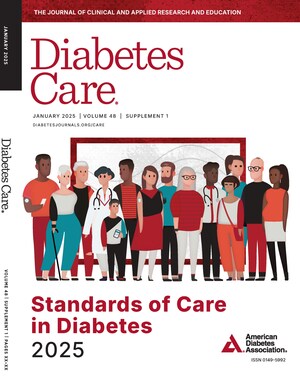ARLINGTON, Va., March 8, 2018 /PRNewswire-USNewswire/ -- The ADA is deeply concerned by the new guidance, "Hemoglobin A1C Targets for Glycemic Control with Pharmacologic Therapy for Nonpregnant Adults with Type 2 Diabetes Mellitus: A Guidance Statement Update From the American College of Physicians," published in the Annals of Internal Medicine on March 5, 2018. While there are several topics listed in the American College of Physicians' (ACP's) statement on which we agree, there are several significant areas that do not align with ADA's 2018 Standards of Medical Care in Diabetes (Standards of Care). The American Diabetes Association has published the annual Standards of Care since 1989, the global resource for the optimal treatment and prevention of diabetes and diabetes-related complications.
The ADA has long recommended that treatment goals be individualized based on factors both modifiable and nonmodifiable, such as age, life expectancy, duration of disease, resources and support, and comorbid conditions. The ADA recommends that a reasonable A1C goal for many nonpregnant adults with type 2 diabetes is less than 7 percent based on the available evidence to date from the ACCORD, ADVANCE, VADT and UKPDS international clinical trials, which were evaluated and incorporated into ADA's Standards of Care.
ACP's new guidance does not consider the positive legacy effects of intensive blood glucose control confirmed in multiple clinical trials and, therefore, are not reflective of the long-term benefits of lower A1C targets. There is clear, convincing evidence of a long-term reduction in diabetes complications with A1Cs at and below 7 percent. ADA is also concerned by the missing consideration of the positive impact of several newer medication classes (SGLT2 inhibitors and GLP-1 receptor agonists) that are associated with low risk for hypoglycemia, have favorable effects on weight and improved cardiovascular disease outcomes.
"The ADA believes all people diagnosed with type 2 diabetes can be healthy and should have the opportunity to reduce their risk of serious diabetes complications through appropriate blood glucose targets," stated ADA's Chief Scientific, Medical and Mission Officer William T. Cefalu, MD. "Individualization of targets is the key factor in designing the most appropriate regimen for patients with Type 2 diabetes. However, by lumping 'most' people with type 2 diabetes into a 7 to 8 percent target range, ACP's new guidance could cause increased complication rates for those who may safely benefit from lower evidence-based targets. Multiple clinical trials confirm increased additional risk of complications among patients who are above an A1C of 7 percent."
The ADA recommends deintensification or simplification of complex regimens to reduce the risk of hypoglycemia in older adults, if this can be achieved within the individualized A1C target. The key is to individualize the A1C target based on patient factors—and any deintensification should be based on these factors, such as the presence of severe hypoglycemia, and not on a number. ACP's guidance for deintensification is contrary to the collective evidence, which confirms lower A1Cs reduce complications with no lower limit on benefit and should be pursued and maintained as long as there is minimal risk of hypoglycemia.
With regards to an emphasis on minimizing symptoms of high blood glucose rather than target A1C levels in certain very old or very sick patients, ACP's guidelines are consistent with ADA's end-of-life recommendations. However, the ADA disagrees that this applies broadly to anyone over age 80, anyone living in a nursing home, or anyone with chronic conditions and who has a limited life expectancy. Each specific case should be evaluated individually, as a person living in a nursing home or with a chronic condition may yet have some years to live, and would likely prefer to live them without diabetes complications. It's important to note that the average life expectancy for an 80-year-old man is more than 8 years, and it's nearly 10 years for a woman of the same age. And that's an average—for some individuals, it's even longer.
Everyone agrees that care should be individualized and that the focus should be on patients; however, the details are critical and specific for each patient. All clinicians caring for people with diabetes should rely on the same patient factors to develop A1C targets with their patients, and so A1C targets should not vary between types of clinicians or clinical settings.
"ADA urges health care providers to continue to develop personalized care plans that can yield optimal short and long-term results for each individual with diabetes—improved quality of life and health outcomes. And every person with diabetes should have the opportunity to reduce and minimize their risk of the serious complications of diabetes, which can be achieved by lower A1C targets and with management strategies that provide acceptable clinical benefit given the known risks. We stand by the recommendations in our Standards of Care and the detailed evaluations of the landmark clinical trials from which they were derived," concluded Dr. Cefalu.
About the American Diabetes Association
Nearly half of American adults have diabetes or prediabetes; more than 30 million adults and children have diabetes; and every 21 seconds, another individual is diagnosed with diabetes in the U.S. Founded in 1940, the American Diabetes Association (ADA) is the nation's leading voluntary health organization whose mission is to prevent and cure diabetes, and to improve the lives of all people affected by diabetes. The ADA drives discovery by funding research to treat, manage and prevent all types of diabetes, as well as to search for cures; raises voice to the urgency of the diabetes epidemic; and works to safeguard policies and programs that protect people with diabetes. In addition, the ADA supports people living with diabetes, those at risk of developing diabetes, and the health care professionals who serve them through information and programs that can improve health outcomes and quality of life. For more information, please call the ADA at 1-800-DIABETES (1-800-342-2383) or visit diabetes.org. Information from both of these sources is available in English and Spanish. Find us on Facebook (American Diabetes Association), Twitter (@AmDiabetesAssn) and Instagram (@AmDiabetesAssn).
Contact: Michelle Kirkwood, 703-299-2053
[email protected]
SOURCE American Diabetes Association
Related Links
WANT YOUR COMPANY'S NEWS FEATURED ON PRNEWSWIRE.COM?
Newsrooms &
Influencers
Digital Media
Outlets
Journalists
Opted In






Share this article